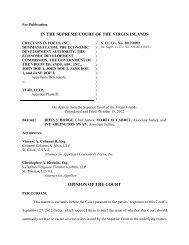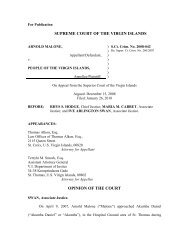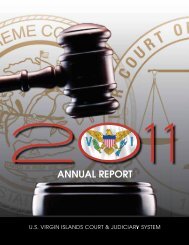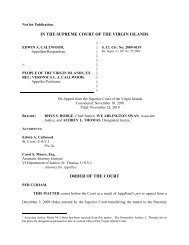IN THE SUPREME COURT OF THE VIRGIN ISLANDS OPINION OF ...
IN THE SUPREME COURT OF THE VIRGIN ISLANDS OPINION OF ...
IN THE SUPREME COURT OF THE VIRGIN ISLANDS OPINION OF ...
Create successful ePaper yourself
Turn your PDF publications into a flip-book with our unique Google optimized e-Paper software.
Murrell v. PeopleS. Ct. Crim. No. 2009-0064Opinion of the CourtPage 6 of 13event this Court agrees that there are no non-frivolous grounds for appeal, this Court shall notonly grant the motion to withdraw, but dismiss the appellant’s appeal. Id. at *4. However, thisCourt recently clarified that “[w]hile an argument may lack merit when it is ‘against the weightof legal authority,’ it is not a frivolous argument unless it ‘is not only against the overwhelmingweight of legal authority but also entirely without any basis in law or fact or without any logicsupporting a change of law.’” Castillo, 2010 WL 500439, at *2 (quoting State v. Turner, No.W1999-01516-CCA-R3-CD, 2000 WL 298696, at *2 (Tenn. Crim. App. Mar. 17, 2000)).B. Drawbacks of the Anders ProcedureThe Anders procedure, however, only “presents the minimum level of protection to whicha criminal defendant is constitutionally entitled on appeal,” for Anders does not represent “aconstitutional mandate not subject to modification.” State v. Cigic, 639 A.2d 251, 252-53 (N.H.1994). As the United States Supreme Court has recently explained,the Anders procedure is not “an independent constitutional command,” but ratheris just “a prophylactic framework” that we established to vindicate theconstitutional right to appellate counsel announced in Douglas. 481 U.S., at 555,107 S.Ct. 1990. We did not say that our Anders procedure was the onlyprophylactic framework that could adequately vindicate this right; instead, bymaking clear that the Constitution itself does not compel the Anders procedure,we suggested otherwise. Similarly, in Penson v. Ohio, 488 U.S. 75, 109 S.Ct. 346,102 L.Ed.2d 300 (1988), we described Anders as simply erecting “safeguards.”488 U.S., at 80, 109 S.Ct. 346. . . . [A]ny view of the procedure we described inthe last section of Anders that converted it from a suggestion into a straitjacketwould contravene our established practice, rooted in federalism, of allowing theStates wide discretion, subject to the minimum requirements of the FourteenthAmendment, to experiment with solutions to difficult problems of policy.Smith v. Robbins, 528 U.S. 259, 273, 120 S.Ct. 746, 757, 145 L.Ed.2d 756 (2000).Numerous jurisdictions, recognizing the multitude of problems inherent in the Andersprocedure, have accepted the Supreme Court’s invitation to alter or outright eliminate the Andersframework. First, the requirement that court-appointed attorneys submit briefs explaining why
















